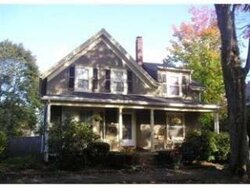My daughter's room is upstairs from the room with our insert, and the chimney runs through her closet. This evening when I was getting her ready for bed, her rooms felt unusually warm. I felt the wall behind which the chimney runs, and the plaster wall was warm to the touch -- I checked against another interior wall, which was cold to the touch. Inside her closet, the upper section of the wall next to the chimney was quite warm. Not hot like hot water from the faucet, but very warm. I read about the symptoms of chimney fires, and went outside just not to see if there were any flames/heavy smoke coming out the chimney, but fortunately none. I don't think this was a chimney fire, but what else could this be from?
Background:
Vermont Castings Montpelier insert, installed in a 1900 masonry fireplace. We had it installed this past October, with a full stainless 6" steel chimney liner. The installer wrapped some kind of insulation around the liner before running it into the chimney. He installed block off plates at the top and bottom. We've been running the insert a lot this week, as the temperature was a daytime high of 15 and nighttime low of 5 or below. We had a very hot fire this afternon, as I just scored a bunch of 2 year old oak.
I've burned about 2 cords of wood since we got the insert installed. 1 cord of this was well seasoned, and 1 cord was sold to me as "seasoned", but I've since learned it was quite green, about 30% moisture content. The oak I just picked up today was 11%. Anyway, it's certainly possible that the green cord created some creosote, but I tried to run the fire hot and mix it in with the well seasoned wood.
Any ideas? I'm letting the fire run out tonight (it's down to mostly ashes right now), and I'm planning to call the chimney sweep to come inspect/clean. Any one seen similar symptoms and have some idea to share?
Background:
Vermont Castings Montpelier insert, installed in a 1900 masonry fireplace. We had it installed this past October, with a full stainless 6" steel chimney liner. The installer wrapped some kind of insulation around the liner before running it into the chimney. He installed block off plates at the top and bottom. We've been running the insert a lot this week, as the temperature was a daytime high of 15 and nighttime low of 5 or below. We had a very hot fire this afternon, as I just scored a bunch of 2 year old oak.
I've burned about 2 cords of wood since we got the insert installed. 1 cord of this was well seasoned, and 1 cord was sold to me as "seasoned", but I've since learned it was quite green, about 30% moisture content. The oak I just picked up today was 11%. Anyway, it's certainly possible that the green cord created some creosote, but I tried to run the fire hot and mix it in with the well seasoned wood.
Any ideas? I'm letting the fire run out tonight (it's down to mostly ashes right now), and I'm planning to call the chimney sweep to come inspect/clean. Any one seen similar symptoms and have some idea to share?



